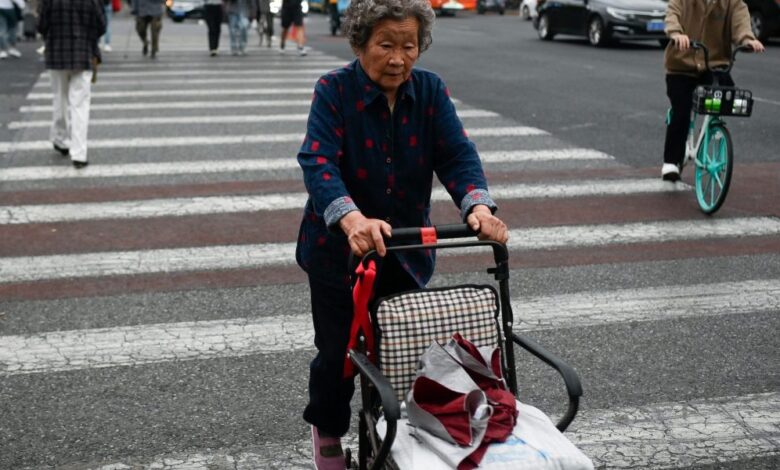
[ad_1]
Some economists are worried that China’s aging population and debt-fueled, real estate-focused economic model are leading it toward “Japanification.” That’s jargon for a lengthy period of deflation, low economic growth, and weakness in the property market that can be caused by financial distress from extreme debt loads.
Veteran strategist Ed Yardeni, founder and president of Yardeni Research, on Tuesday even wrote a note titled “China: The World’s Largest Nursing Home,” detailing some of his fears about the future for the world’s second-largest economy.
Like many of his peers, Yardeni pointed to the ailing property market—which had soared for years on the back of cheap debt and immense economic and population growth—as well as China’s disturbing demographic trends, as the key concerns for the Chinese Community Party (CCP). Falling home and stock prices will lead Chinese consumers to spend less and save more to “offset the erosion” of their wealth in coming years, he argued. And that’s a recipe for a low growth and a deflationary economy—a.k.a. Japanification—when the population is declining.
But interestingly, China’s issues may be a boon for many Western nations, at least in the near term. “China’s economy is in a property-led and fertility-led depression,” Yardeni wrote. “That’s bad news for China’s people and for the Chinese Communist Party (CCP) but benefits countries that import Chinese goods at depressed prices.”
Bad news for China, good news for the U.S.
Yardeni explained that China’s “weak economy” is especially good news for the U.S., as it has forced Chinese goods exporters to lower their prices, helping to slow rising costs for many products in the U.S. That’s been a key goal of the Federal Reserve over the past 20-plus months in its fight to tame inflation with interest rate hikes. Yardeni argued that China’s economic issues have helped create an “immaculate disinflation” in the U.S., enabling the Fed to lower inflation without sparking a recession.
China’s ailing economy could also be good news for U.S.-China relations—and by extension, stocks—moving forward, according to the veteran market watcher. U.S.-China tensions have led to sanctions and export restrictions between the nations, which have hindered both U.S. and Chinese corporate earnings in recent years. But the current era of protectionism is less likely to continue with China’s economy struggling.
“It would be in China’s interest to attract more foreign direct investment to shore up its economy To achieve that, the Chinese government may have to become less confrontational in matters of foreign affairs, especially vis-vis Taiwan,” he wrote. “On balance, these are all positive developments for the U.S. stock market.”
Startling statistics about ‘China’s geriatric demographic profile’
Yardeni went on to list a few key statistics that demonstrate China’s demographic problems.
The first and most important issue he pointed to was the declining fertility rate. China is far from alone when it comes to declining birth rates—the U.S. fertility rate has fallen to just 1.64 births per woman—but it is facing a more extreme version of the phenomenon.
China’s fertility rate (births per woman) has been below the breakeven level of 2.0 since 1991, and it fell to just 1.16 in 2021. “The Chinese aren’t having enough babies to replace themselves,” Yardeni argued.
The effect of the declining fertility rate is a shrinking number of annual births. “In 2022, there were 956,000 births in China, the lowest on record, ” Yardeni explained, pointing to data back to 1950. “That’s down 50% from 10 years ago.”
After peaking at 1.41 billion in 2021, China’s population declined by 850,000 last year, the first decline since 1961.
The scary part is that Japan faced similar fertility rate issues beginning in the 1970s, ultimately leading to an era in the 1990’s known as “the lost decade” during which economic growth stagnated as population growth stalled. By 2008, Japan’s population began to decline—and that continues today. Economists believe this decline is one of the main reasons the Japanese economy has faced decades of low growth and stagnant prices.
But wait, it’s far from just doom and gloom in China
While Yardeni fears that China’s demographic issues are likely to weigh it down for years to come, there are some positive signs that the country’s economy is beginning to recover after a rough pandemic-era. And, of course, demographic trends are just that, and aren’t set in stone.
In a November 23 note, Capital Economics’ China Activity Proxy, an alternative measure of GDP for the country showed the Chinese economy made strides in October, with broad based growth across the industry, construction, and services sectors. Retail sales also rose amid improving consumer sentiment in China. And despite the rise in youth unemployment in the country, the overall unemployment rate “remains low by past standards,” according to Capital Economics.
Government efforts to strengthen the property sector—including measures to improve developers’ access to financing and reducing mortgage rates—have also helped to boost GDP growth in China.
Bank of America economists, led by global economist Claudio Irigoyen, explained that they even expect the housing market to “stabilize” in the first half of 2024 after tumbling for months. Irigoyen forecasts relatively robust 4.8% GDP growth for China in 2024, followed by 4.6% growth in 2025.
While some economists have warned that China faces Japanification, Irigoyen believes the government can still fix the situation.
“We believe China can avoid Japanification if policymakers roll out effective measures resolutely to boost confidence and reverse the growth downtrend,” he wrote. “Over the medium to long term, China will need to adopt a multipronged approach and transit to a new growth model.”
However, Irigoyen also warned that if China doesn’t manage to fix its debt-fueled growth model, which has long been based on investment in the now struggling real estate market, it could face serious growth problems. “Falling into long-term stagnation at China’s current income level would be an even drearier scenario than what Japan experienced,” he warned.
Source link




